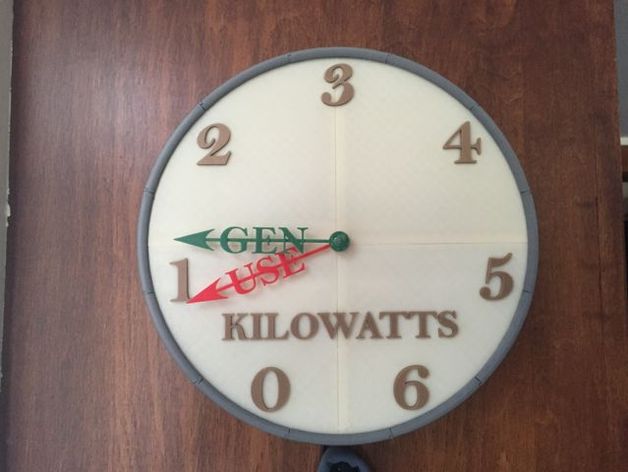
Power Usage and Generation Display
thingiverse
This is a device which displays real-time electricity consumption and solar power production in my house. The information comes from our eGauge energy meter (http://www.egauge.net/) that captures the current electrical usage and generation, then uses an Arduino and two servos to rotate the dials to show the current values. If you don't want to make this yourself, you can check the output of our eGauge at http://egauge14368.egaug.es . Having the eGauge has made my whole family more conscious of electricity usage, but we had to turn on a computer or tablet to see how much power is being used in real time, which makes it easy for everyone to stay informed without needing a screen. Instructions Some aspects of this project are specific to our eGauge installation, so you'll need to adjust the Arduino code if you want to create something similar. Many of the variables that need changing can be found at the beginning of the sketch. This project requires basic soldering and assembly skills with electronics, so it's not suitable for those who are inexperienced in these areas. The dial is designed to show values up to six kilowatts, but your situation might differ - you could consider building a different-sized dial for your needs. You'll need to purchase or already have the following electronic components: An Arduino Uno board. I used SparkFun's RedBoard, which can be found at https://www.sparkfun.com/products/12757. A WiFi or Ethernet shield that is compatible with Arduino. My sketch is written for SparkFun's CC3000 WiFi shield (https://www.sparkfun.com/products/12071). If you use a different network module, you will need to adjust the code accordingly. A Pololu servo controller (https://www.sparkfun.com/products/8897) to control the servos. This was necessary because the Arduino Servo library and CC3000 library conflict, but you can probably just use the digital out pins on the Arduino if you want to save some money by rewriting part of the code. Two standard-size servo motors (https://www.sparkfun.com/products/11884). A few M3 screws for mounting the electronics. To build this dial, print one each of all parts except for: Print two Gear Holder Print four Servo Mount Print ten Rim1 First, remove the servo horn from each servo and install a servo gear on each. Next, attach the servos to their respective mounts using the screws that came with them. The 3D-printed components all have smooth sliding parts or click into place - simply assemble everything as indicated by the diagram.
With this file you will be able to print Power Usage and Generation Display with your 3D printer. Click on the button and save the file on your computer to work, edit or customize your design. You can also find more 3D designs for printers on Power Usage and Generation Display.
